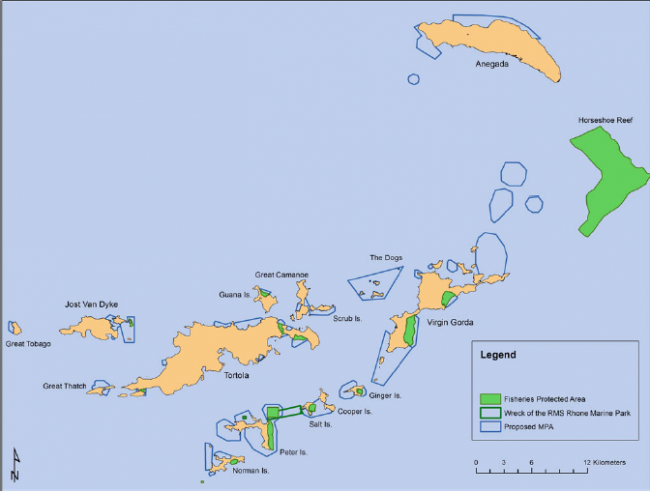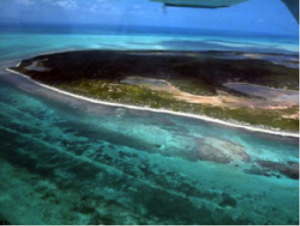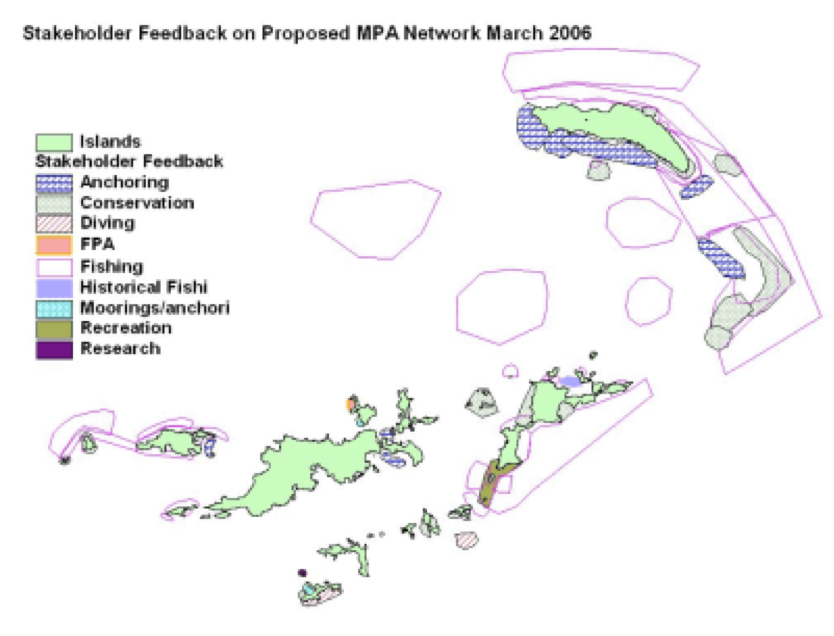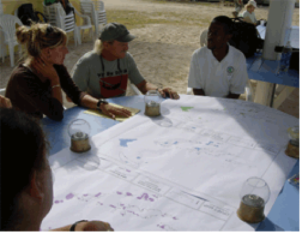Creation of a Marine Protected Area Network to Protect Underwater Habitats in the British Virgin Islands
Location
British Virgin Islands Marine Protected Area (MPA) Network
The challenge
The British Virgin Islands (BVI) are located 100 km east of Puerto Rico in the northeastern Caribbean and are part of the Leeward Islands, which stretch from the BVI to Antigua. Composed of over 60 islands and cays, the BVI represent a total land area of 153.67 km2 (59 square miles). Every island in the BVI is surrounded by coral reefs of varying size, health and composition. The Anegada Horseshoe Reef is the third largest continuous reef in the Eastern Caribbean at 63 km long, containing both patch reefs and barrier reefs. There are 63 popular dive sites in the BVI, which include 57 coral reef sites and 6 artificial reefs that have been created by shipwrecks. Tourism accounts for about 45% of the national income.
The BVI has been threatened by both natural disasters and anthropogenic impacts. Hurricanes have frequently impacted the area over time, and flooding from torrential rains has resulted in landslides, which subsequently harm marine resources due to increased sedimentation. The bleaching event of 2005 had devastating impacts, resulting in almost 90% of the BVI reefs being bleached. Hurricanes in 2008 and 2010, and an extreme wave event in 2010 also affected the reefs. Human impacts on the BVI are vast and include the following: anchor damage from boats and ships; coastal development; increased sedimentation due to development on steep slopes, the creation of unpaved roads, and improper erosion control; sewage discharge from charter and private vessels and ocean outfall disposal of terrestrial waste; overcrowding of vessels; overharvesting of conch, spiny lobster and whelks; destructive fishing practices.
Actions taken
The British Virgin Islands has declared 14 protected areas, including one marine park managed by the National Parks Trust of the Virgin Islands (NPTVI) and 13 fisheries protected areas, managed by the Conservation and Fisheries Department (CFD). Another 40 areas have been identified for inclusion in a Marine Protected Area Network. The primary goals of the British Virgin Island MPAs are:
- To create a marine protected area network that reflects the major marine and coastal habitats of the BVI;
- To protect 30% of the important biological habitats across the BVI, including hard and soft corals, seagrasses, mangroves, turtle nesting beaches, and fishery habitats;
- To cluster protected areas together so that they can be easily managed; and,
- To ensure that there are protected areas across the BVI to enhance resilience.
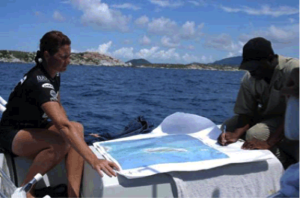
Shannon Gore, Conservation and Fisheries Dept., and Finfun Peters, National Parks Trust of the Virgin Islands, ground truthing sites using aerial photographs as a guide. Photo © BVI National Parks Trust
The overall goal was to create a system of protected areas for the BVI, in order to have a more comprehensive approach to protected area planning. The National Parks Trust of the Virgin Islands, the Conservation and Fisheries Department and The Nature Conservancy collaborated to train relevant staff on Marxan. Four potential MPA networks that included areas identified as important due to their biodiversity, importance as fish nurseries or breeding habitats were created using Marxan. Each potential MPA network included 30% of each biological habitat type and varying levels of clustering of MPA areas and locked-in areas (areas that are intended to be protected regardless of outcome). The BVI was divided into three geographic units to build resilience into the network through even distribution of MPAs in each unit. This process eliminated the potential to place heavy reliance on an extensive reef system around the island of Anegada to the detriment of other areas. These maps were then taken to stakeholders, including fishers, dive operators, charter boat industry and relevant government departments for feedback. To ensure participation in the stakeholder review process, meetings were organized on the four main islands in the BVI using existing organizations such as fisheries associations, the Charter Yacht Society, the Dive Operators Association, and the Marine Association. As the National Parks Trust of the Virgin Islands has a long-established relationship with the charter and dive industry, due to over 25 years of managing mooring buoys in sensitive reef sites, it was relatively easy to ensure the participation of this sector of the marine industry. However, the National Parks Trust of the Virgin Islands did not have a similar relationship with fishermen. The fisheries extension officers at the Conservation and Fisheries Department were critical in assisting with this process because the fishers recognized and responded to their requests to attend the stakeholder meetings. Separate meetings were held for fishermen and the dive/charter industry due to the potential conflict of interests, and to make participants feel more comfortable when providing feedback. The main focus of the meetings was to have stakeholders draw on large, printed maps that displayed the four MPA network models, indicating areas they currently use for fishing, diving, and anchoring, in addition to making suggestions of areas that should be protected. Stakeholders were also asked to select the MPA network model they preferred the most. One MPA network model was selected based upon all feedback, which was the one with the highest level of clustering and locked-in areas and was slightly modified based on all stakeholder input. This map was then included in the overall proposed System Plan of Protected Areas for the BVI and approved by the Cabinet in early 2008.
Following onto the initial Marxan analysis and System Plan development, a new project—the 2021 BVI Coastal Resource Atlas and Temporal Analysis, a UK Darwin Plus-funded project, is being led by Dr. James Strong of the United Kingdom National Oceanography Centre, in partnership with the Virgin Islands Government and the National Parks Trust of the Virgin Islands. This project will update the coastal resource atlas that was created in 2005 and which formed the base layer for the Marxan analysis. Additionally, as of 2022, there is a new version of the System Plan of Protected Areas being developed, but it will focus primarily on terrestrial areas and will still include the 2007-2017 proposed MPAs.
How successful has it been?
The Trust is now collaborating with the Survey Department to create the legal maps for these areas so that they can be officially designated as MPAs. These maps will then be used to consultatively create the zoning plan for the MPAs. In addition to this the boundaries of the MPAs and zones will be identified in the marine environment using marker buoys. As the MPA network is very extensive, a public relations campaign will be required to inform all stakeholders of the zones and permitted use. This will include all media sources, such as internet, newspapers, publications and brochures in the BVI and the US Virgin Islands. As of 2022, the MPAs had not yet been implemented.
Lessons learned and recommendations
- Selecting areas that are naturally protected from use due to location, rough seas, or depth assisted in achieving conservation goals with less stakeholder conflict.
- Stakeholder meetings and government involvement throughout the planning process ensures that everyone is aware of the MPA goals (the 30% goal became very well known in the BVI and regionally).
- A greater understanding of the stakeholder groups is important. As the National Parks Trust of the Virgin Islands did not traditionally have a relationship with fishermen, it was not always possible to engage fisherman. Therefore, working with the Conservation and Fisheries Department fisheries extension officers was essential and helped improve these relationships.
- Stakeholder meetings must be located in the communities where fishermen live and a relationship must be created with community members.
- The way in which information is presented to stakeholders can affect how much feedback is provided in return. For example, using large paper maps laid out on tables enabled people to look at, draw on, and talk informally about the areas. People were also more inclined to attend meetings when they saw that their opinions were being recorded and taken into consideration.
- It is critical to build trust between the government and the community. This entails continued engagement of stakeholders throughout the MPA planning process, particularly when zoning areas. In some cases, areas may have to be swapped (e.g., if 30% of a habitat can still be achieved by protecting another area and there is less conflict, then it may be wise to swap).
- Many small island nations do not have access to university experts or scientific researchers so field work can be limited by capacity issues and resources. Therefore, scientific, management, and monitoring training is an important part of the long term project goals. Finding the right people to undergo training is equally important to ensure that capacity is retained within an organization.
- Building in resilience using geographic distribution across an area and natural features can reduce conflict between stakeholders and conservationists. For example, some areas that have been included in the MPA network are located on the north or south sides of islands that are naturally too exposed, deep or rough to be utilized by stakeholders, therefore there is no conflict involved in protecting the area, but the 30% goal of habitat protection is still being achieved.
Funding summary
Overseas Territories Environment Programme
NOAA National Ocean Service
The Nature Conservancy
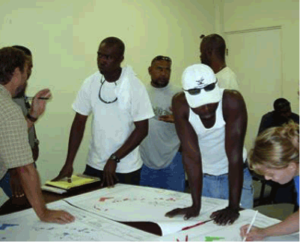
TNC and NPT staff discuss the maps with the Fisheries Association of Virgin Gorda. Photo © National Parks Trust of the Virgin Islands
Lead organizations
National Parks Trust
University of Warwick Life Sciences
The Nature Conservancy Eastern Caribbean Program
Partners
University of Warwick
The Nature Conservancy Eastern Caribbean Program



